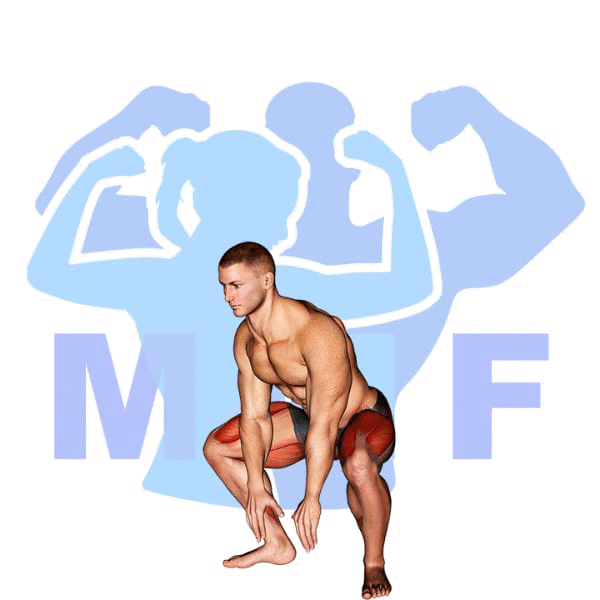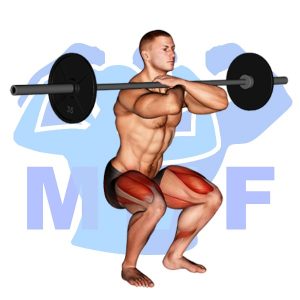Are you struggling to perfect your squat jump? Don’t worry, you are not alone! Many fitness enthusiasts find it challenging to master this move due to improper form and technique. It’s understandable, as the squat jump requires proper coordination, balance, and power. If you are feeling frustrated or discouraged, know that it’s a common issue that many people face. The good news is that with the right guidance and practice, you can conquer your squat jump form and technique. In this post, we will provide you with some expert tips and tricks to help you perfect your squat jump and take your fitness to the next level!
Squat Jump Summary
- Primary Muscles: Quadriceps
- Secondary Muscles: Adductor Magnus, Gluteus Maximus, and Soleus
- Equipment: Body Weight
- Mechanics Type: Compound
- Force: Push
- Utility: Basic or Auxiliary

Squat Jump Instructions
- Stand feet shoulder-width apart, and your toes slightly pointed out.
- Squat down by bending your hips back while allowing your knees to bend forward and lower your hand down pointed to the floor.
- The explode up, jumping off the ground and reaching your hands up.
- Prepare to land on the ball of your foot to your heel, and absorb the landing with your feet, knees and hips as you return directly to the down position of the squat.
- Explode again for your next rep and repeat for a set of 10-15 reps.
Video Tutorial
Squat Jump Muscles
Target (Agonist)
Synergists
- Adductor Magnus
- Gluteus Maximus
- Soleus
Dynamic Stabilizers
Stabilizers
- Erector Spinae
- Levator Scapulae
- Trapezius – Middle
- Trapezius – Upper
Antagonist Stabilizers

Benefits of Squat Jump
The squat jump is an incredibly effective exercise to include in a strength training or fitness routine, as it works a variety of muscles, including the quadriceps. The quadriceps are a group of four muscles located on the front of the thigh. When performing the squat jump, these muscles are challenged by the rapid movement of quickly moving up and down and the force generated by jumping. This intense movement helps to strengthen and tone the quadriceps, leading to greater muscular power and agility. Additionally, squat jumps can help to improve overall muscular endurance and balance, making them an ideal exercise for those looking to increase their strength and fitness level.
Tips for Performing Squat Jump
squat jumpquadriceps
- Start Slowly: Start with smaller jumps and work your way up to bigger ones. This will help you get used to the movement and reduce the chance of injury.
- Engage Your Core: Keep your core engaged throughout the exercise, as this will help you maintain proper form and maximize the benefits.
- Stay Focused: Make sure you focus on the movement and don’t rush through it – this will help you get the most out of each rep and ensure that you’re getting a good workout.
Benefits and Tips Video
Frequent Mistakes To Avoid
When executing squat jump, avoiding typical errors is usually the difference between an effective workout and a painful injury. Additionally, achieving optimal results from this exercise requires proper form, and avoiding perform common errors can help you to perform the exercise correctly and obtain optimal results. Not only can preventing these errors make you stronger, but also can assist in you feeling more confident and inspired when at in the gym. Let’s start by staying away from these typical errors and add this exercise to your training regimen.
- Not engaging their core muscles: Squat jumps require a strong core to maintain proper form and technique, which is essential for avoiding injury.
- Not using proper form: Poor form can lead to an increased risk of injury, as well as reduced effectiveness of the exercise.
- Not jumping high enough: Jumping too low limits the amount of work done by the leg muscles and can make it difficult to build strength and stamina.
Find More Bodyweight Exercises Here
Variations and Complementary Exercises
To increase the effectiveness of the squat jump exercise, it is important to vary your routine. There are several variations, complementary, and alternative exercises to the squat jump that will help target similar muscles and increase strength and endurance. These include:
Squats With Bands

Squats with Bands is an effective, low-impact exercise that is complementary or an alternative to the Squat Jump. This exercise uses bands to add resistance to the traditional squat movement and is a great way to target the glutes, quads, and hamstrings. The bands provide a variable resistance throughout the range of motion, which helps to develop strength, balance, and stability. Squats with Bands can also help increase power and explosiveness, making it a great way to supplement or replace the Squat Jump in any workout routine.
Barbell Front Squat Clean Grip

The Barbell Front Squat Clean Grip is a great exercise to complement or even replace Squat Jumps in a workout routine. This exercise is similar to the traditional Squat Jump but requires the use of a barbell, which allows you to add additional weight to the exercise. To perform this exercise, you must begin by standing with feet slightly wider than hip-width apart, gripping the barbell with an overhand grip and holding it in front of your chest. You then squat down until your thighs are parallel to the floor and then explosively jump up while keeping the barbell in place. This exercise is great for targeting all the same muscle groups as Squat Jumps while adding additional weight.
Barbell Front Squat Cross Arm Grip

The Barbell Front Squat Cross Arm Grip is an excellent exercise for strengthening the legs and core muscles. It is performed by holding a barbell in the front of the body with arms crossed over the bar, then squatting down until the thighs are parallel to the ground. This exercise is complementary to the Squat Jump because it helps to develop strength in the same muscle groups while also helping to improve balance and coordination. Additionally, it can be used as an alternative exercise if one is looking to reduce the intensity of the Squat Jump, allowing them to still gain strength and stability while avoiding any potential injuries.
Check Out These Top Bodyweight Exercises
Barbell Front Sumo Squat

Barbell Front Sumo Squat is a great complementary or alternative exercise for Squat Jump. This exercise works the same muscles as the Squat Jump but in a slightly different way. Instead of jumping up, the weight is held in front of the body at shoulder level and the movement is a squat down with the legs wide apart and chest up. The weight is then brought back up to the starting position. This exercise will help build strength in the quads, glutes, and core muscles and is a great way to add variety to your leg workout.
Barbell Full Squat

The Barbell Full Squat is an excellent complementary or alternative exercise for the Squat Jump. This exercise involves holding a barbell across your upper back, standing with your feet shoulder-width apart, and then squatting down until your thighs are parallel to the floor. This exercise is great for working out your entire lower body, including your glutes, hamstrings, and quadriceps. It also works your core muscles and helps to improve overall balance. The Barbell Full Squat is a great way to increase the intensity of your workout, while still providing you with a great lower body workout.
Barbell High Bar Squat

The Barbell High Bar Squat is an exercise that is similar to the Squat Jump, but it requires the use of weights and a barbell. This exercise can be used as a complementary or an alternative to the Squat Jump, as it focuses on strengthening the legs and core more than the Squat Jump does. This exercise also helps to increase balance, coordination, and flexibility while targeting the quads, glutes, and core muscles. The Barbell High Bar Squat can be a great addition to any workout routine, as it helps to improve both strength and power.
Find More Legs Exercises Here
Opposing Complementary Exercises
In order to ensure that your workout is balanced and effective, it is important to include exercises that work opposing muscle groups. This will help to prevent injury and ensure that you get the most out of your workout. To complement your Squat Jump, you can add the following exercises to your routine:
Barbell Reverse Lunge

The Barbell Reverse Lunge is a great exercise to complement Squat Jumps. By targeting the opposite muscle group, the Barbell Reverse Lunge works the hamstrings and glutes, while the Squat Jump targets the quads and calves. By performing both exercises in tandem, you can build strength and stability in both the upper and lower body, while also improving balance. Additionally, the Barbell Reverse Lunge is great for improving hip mobility, which helps to make your Squat Jumps more effective.
Barbell Walking Lunge

Barbell Walking Lunge is an effective exercise for developing lower body strength and power. It works the opposing muscle groups of the Squat Jump, such as the hamstrings, glutes, and quads. By performing Barbell Walking Lunge after Squat Jump, you are able to target different muscle groups and create balance in your lower body. This helps to improve overall strength, power, and stability in the lower body, making it a great complement to Squat Jump.
Dumbbell Lunge

The Dumbbell Lunge is a great complement to Squat Jumps, as it works the opposing muscle group. The lunge focuses on the lower body, engaging the glutes and quads as well as the hamstrings, while the squat jump works the upper body and core. The combination of the two exercises allows for a full body workout that can target all major muscle groups and help improve overall strength, balance, and coordination.
Take Your Squat Jump to the Next Level
Are you bored with your typical squat jump routine? It’s time to take things up a notch and challenge yourself with some advanced variations. Not only will this mix things up and prevent you from hitting a plateau, but also it will give your lower body a killer workout. The benefits of squat jumps go beyond just strengthening your muscles – this exercise can help with explosive power, agility, and overall athleticism. Ready to take your squat jumps to the next level? Keep reading for some intense variations.
References: Wikipedia | ExRx.net | PubMed.gov | Comprehensive List of Legs Bodyweight Exercises




